This content contains affiliate links. When you buy through these links, we may earn an affiliate commission.
Between social media bans, the slow destruction of Twitter, and the fight over the Kids Online Safety Act (which promises to deliver just the opposite), news about the dangers of technology is everywhere. No matter how technology itself changes, though, it’s not going away, so it’s important that we teach children how to use it safely and to remind ourselves of best practices as well.

That is the goal of (Be Smart About) Screen Time, Rachel Brian’s latest comic book. While aimed at children, the book’s simple yet cute art and digestible advice about how to enjoy the perks of modern technology while avoiding its many pitfalls speak to everyone. There are, in fact, perks, no matter how scary the headlines are. Brian, founder of the educational animation company Blue Seat Studios, went out of her way to emphasize this in her book.
“Adults often feel a lot of anxiety about kids being online, but we also have to recognize that technology is a huge and exciting part of kids’ lives,” she told me in an email interview. “The goal is to encourage caution and thoughtfulness without instilling fear.”
It’s never too early to start. According to her book, the American Academy of Pediatrics says that children can start enjoying limited, supervised screen time when they are between three and five years old. Brian believes that lessons on-screen safety should begin at the same time:
It’s never too early to start modeling good habits! Even if you’re co-watching content with a toddler, you can talk about the choices you’re making: why you’ve picked a certain app or video and how you’re using screens thoughtfully and intentionally….When kids start using screens independently, they’ll ideally already be familiar with these habits because you’ve modeled them early on.
Parents, says Brian, play a vital role in helping their children safely navigate the internet, but that role shouldn’t be demanding or prescriptive. “Lectures don’t work for kids (or anyone, really),” says Brian. Instead, focus on modeling good behaviors, giving them “tools to reflect” on their experiences, and letting them know that you are willing to talk about anything they are confused or troubled about.
“The goal is to have open communication so [your kids] feel comfortable sharing their online experiences with you,” Brian says.
Even adults without children can help make the internet more welcoming for people of all ages. If you feel you missed out on some important online safety lessons, it’s never too late to get back to basics and rethink your approach to technology. At its core, however, Brian believes that internet safety begins with something surprisingly simple:
Bring your values with you online….If you believe in being kind, trustworthy, and open-minded in real life, then carry that into your online interactions too.
For both kids and adults, learning to act from your values is crucial. Support others, avoid trolling or bullying, and think before amplifying misinformation or meanness. Collectively, we shape the online community through our input. If we approach the internet with kindness and integrity, we can create a more positive and safe online community—for everyone.
That may sound obvious, but it’s an easy lesson to forget when Someone Is Wrong On The Internet and you, protected by the anonymity of your screen, dive in to correct them with extreme prejudice for the amusement of your followers. Like Brian says in (Be Smart About) Screen Time, the moments when emotions are high and the internet makes you feel bad are the best moments to take a screen break — and to reflect on the kind of internet you want to be a part of.

